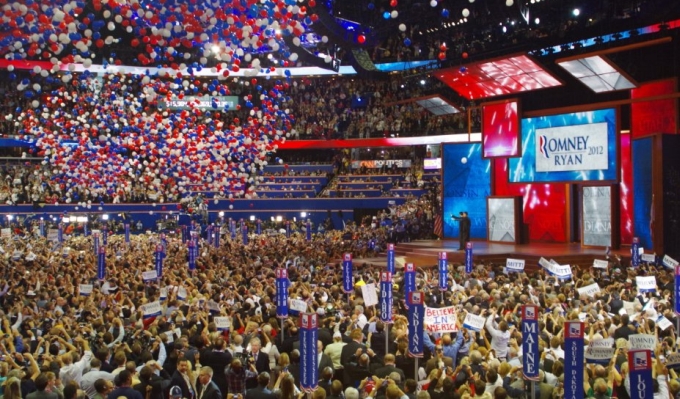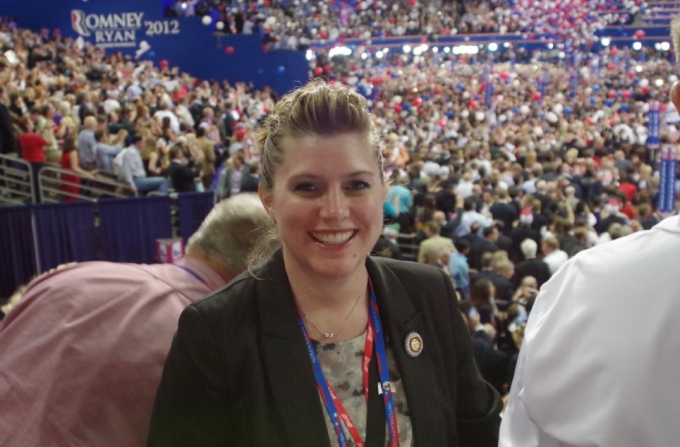Why Green Meetings Matter
- Posted in:
- Interviews

Recycling bins ready to go at the 2008 Democratic National Convention
Over the past year, we've noticed that the blogs and the trade magazines have used terms like "Green Meetings," "Green Event Planning," and "Sustainable Event Management" with increasing frequency.
But just what does it mean to produce a "green" meeting? Are there any real standards that meeting planners need to follow in order to call their meetings and events "green," or is it all just "Greenwashing"? Is it a PR ploy to make the companies and organizations producing meetings and events seem more environmentally conscious, when in their day to day operations they may not actually be practicing what they preach?
To get a better perspective on this issue, we reached out to some folks in the meetings industry, and had a chat with Jaime Nack, president of Three Squares Inc., an environmental consulting agency that helped out with such large events as Jon Stewart's Rally to Restore Sanity and/or Fear, and the Democratic National Conventions in 2012 and 2008. Jaime and her team also did the logistics and greening for the last two conferences for the Green Meeting Industry Council (GMIC). Says Tamara Kennedy, executive director of GMIC, Jaime's team was "Phenomenal and helped us exceed some of our greening goals by working with the local team" at the conference. From her, we learned a lot about just what it means to put on green meetings and events.

Jaime Nack
First of all, green meetings and events aren't just greenwashing. While there may indeed be some greenwashing out there, sustainable event management goes far beyond the surface PR ploy. In fact, according to what we found, many companies actually want to keep their green agendas private.
"For a lot of [our] clients," says Jaime, "It's just something that's part of their internal fiber or their corporate culture and so they want to make sure that they're walking the talk and they're doing it right. But it might not be something that they want to promote externally for fear that if they promote that they're doing X someone might try to dig deeper and say 'Well, what about Y and Z?'"
Many organizations may want to be more sustainable and more green, but they may not be able to comply with all the rigorous industry standards all at once. Thus, smaller gestures like producing a green event can be misinterpreted by the press who say that ABC Corp. is greenwashing when really they're just taking the first small steps toward sustainability. Because of this, many companies and organizations will keep their green initiatives, including their green events, private affairs.
The Lasting Impact of Green Meetings and Events
"That's all well and good," you might say. "But what kind of lasting impact do green meetings and events actually have?" After all, an event is a one-off deal, and while it's nice to produce one sustainable event, what about all the other events out there that aren't sustainable? Couldn't our efforts be better directed elsewhere?

Colorado Convention Center Recycling Station
When talking with Jaime, however, we found that one of the most rewarding aspects of her job was actually the lasting impact her events had. By showing venue staff, (kitchen staff, housekeeping staff, facilities staff, etc.) easy ways to make their event more sustainable, they were then able to adopt those practices for future events regardless of whether or not those future events were planned with sustainability in mind. It's this very light bulb going off, this idea that venue staff and even the people attending the meeting can adopt the same sustainability practices themselves, that is most rewarding for the green event planner.
As Three Squares continues to produce events, the more impact they have. The Colorado Convention Center, for example, kept compost stations on as part of their system ever since the Democratic Convention there in 2008, an event where Jaime and her team helped manage sustainability practices. Also, several smaller hotels whose staff Jaime's team trained decided to keep doing what they were advised to do simply because it made sense as far as sustainability was concerned.
"[Event professionals] live and thrive on that rush of the events coming up--but then when it's over, it's over, and we move on to the next one" says Jaime. "We kind of wish that we had a little bit more impact than the couple of hours when folks were there on-site at the event. So I think this allows you to have that impact…and leave a legacy behind."
What Can Planners Do to Make Their Meetings and Events More Sustainable?
We've covered the "why" of green meetings and events, but what about the "how?" If you're an event planner and you're reading this, how do you get started making your events more sustainable?
We put this question to Jaime and she said that that the key to starting out in the sustainability biz is research. Look at the industry standards that are out there and start to familiarize yourself with those standards and with the tools and resources that are available online.
Once you've familiarized yourself with the standards, "You're able to make choices," says Jaime, "Simple choices: food that you order for menus and choosing not to buy materials that are made thousands and thousands of miles away and shipped over with maybe not fair labor laws in that country. You have the choice and the way of making recommendations and finding and sourcing locally and being able to even price match."

When choosing a meeting space, consider sustainable venues like the io/LA meeting space pictured above. Just so you know, you can use eVenues' advanced search feature to find sustainable and LEED certified venues in the cities where we list venues ;)
Jaime emphasizes that planners are the ones spending money, either "their money or spending their clients money, and they can do it in a way where it's having a positive impact." Having the right knowledge is the way to begin making this impact.
Sustainable Meetings and Events: How the Pros Do It
Green event planners are generally hired to do two things: Plan green events or meetings from the ground up, or to be brought in to manage the sustainability aspect of larger events.
Obviously, when planning an event from the ground up, a lot of the decisions you make will be the same. Now, however, you'll be adding sustainability to the list of criteria you have when making a decision about this or that venue and this or that supplier.
In these situations, Jaime and her team are essentially setting the tone from the venue RFP (Request for Proposal) stage on out. They write their specs into the venue RFP and then once they get proposals back from hotels or convention centers they have site visits with those that rank highest according to their own criteria.
On those site visits, they look at everything: from energy, waste, water and transportation to the distance of the venue to the airport. They have a process of doing a site assessment and diving into those details with whomever the venue contact might be so that the venues can follow the correct practices that they need to have in place in order to earn their business.
For those managing just the sustainability aspect of an event, on the other hand, the job is very similar. Planners will most likely be in the conversations about sustainability practices with whomever the lead is on the planning or production side rather than with the suppliers themselves.
While the event planner may be making sure that they're providing enough food for everyone in the room, a sustainability consultant will be looking at what types what type of food is being served. Is it local produce? What types of fish are on the menu? They'll have language that they'll advise their clients to write into all of the BEOs (Banquet Event Orders) which provides bulleted lists of the the types of items that are preferred, like actual spoons instead of wooden stir sticks for coffee, and linen napkins instead of paper napkins. Furthermore, they'll be working hand in hand with the banquet staff to ensure all waste is being cleared in a way that's in line with sustainability standards.
A Bigger Impact Than You Think
Considering that it contributes nearly a trillion dollars to the U.S. economy, the meetings industry is no small potato. Considering how much water, electricity, and fuel gets consumed and how much waste gets produced for all these meetings and events to run smoothly, the consequences to the environment can't be small.
Because of this, it's important that event planners start thinking about sustainability. Planners have the power to encourage venues and suppliers to adopt sustainability practices, practices which will remain in place long after whatever event they happened to have planned is over. Now is the time for planners to to utilize this power and educate more and more people about sustainability and its importance.


